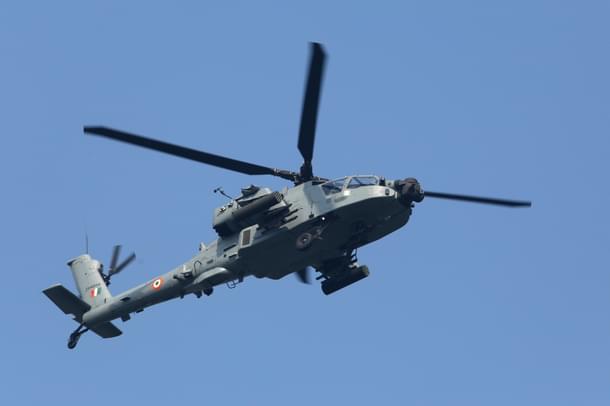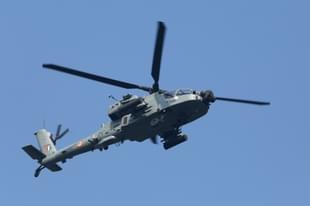News Brief
IAF’s Apache Attack Helicopter Seen Near Border With China In Sikkim Even As Disengagement Continues In Ladakh
Swarajya Staff
Feb 22, 2021, 11:49 AM | Updated 11:53 AM IST
Save & read from anywhere!
Bookmark stories for easy access on any device or the Swarajya app.


In an interesting development, an Apache attack helicopter of the Indian Air Force (IAF) was spotted at a base in Sikkim, near the border with Tibet, last week, even as the border disengagement with China was underway in eastern Ladakh.
In a picture posted by the Public Relations Officer of the Ministry of Defence in Shillong on Twitter, along with the announcement of the visit of Air Marshal Amit Dev, Air Officer Commanding-in-Chief of the Eastern Air Command to Sikkim, the IAF officer can be seen seated in an Apache attack helicopter.
Air Mshl Amit Dev, AOC-in-C, EAC visited forward locations in Sikkim, on 17-18 Feb 21.
— PRO Shillong, Ministry of Defence (@proshillong) February 18, 2021
The Air Mshl interacted troops of @adgpi & @IAF_MCC on his visit & also with the aircrew of Apache Unit, which are deployed in this sector for the first time.@easterncomd @SpokespersonMoD pic.twitter.com/fa77cZNXSX
According to this report, the attack helicopter was present at a “forward base in North Sikkim district, a few kilometers from the Line of Actual Control”.
The development is significant because this is the first image of an Apache attack helicopter of the IAF in Sikkim, and could be signal for the People’s Liberation Army (PLA) — it comes just weeks after Indian and Chinese border troops clashed near Naku La, a pass in north Sikkim, near the border with Tibet.
The attack helicopter, reports say, was part of a unit of Apaches deployed by the IAF in the eastern sector, which includes Sikkim. While one unit of IAF’s AH-64Es is based at Pathankot in Punjab, the other is based at Jorhat in Assam.
India had contracted for 22 Apaches for the IAF in 2015, and all the attack helicopters had been delivered by July 2020. A deal for six Apaches for the Army was signed in February last year, and the numbers are likely to increase further.
Apaches, which are also called ‘tank killers’, were seen flying in and out of the Leh Air Base during the standoff with China in eastern Ladakh, where both India and China had deployed armoured units, only a few feet apart at some places.
Apart from eastern Ladakh, the 17,000-feet-high north Sikkim plateau is perhaps the only other place along the India-China frontier where the Indian Army has deployed tanks and could face armoured units of the PLA in the event of a crisis.
Here's a video of T-72 tanks navigating the frozen Teesta river up north in Sikkim.https://t.co/s05gpqsYRD
— VatsRohit (@KesariDhwaj) April 19, 2020
Apache’s chin-mounted gun can sends 625 armour-penetrating bullets per minute ripping into the targets. It is equipped with Hellfire missile, designed as a heavy tank-killer to destroy Soviet armour on the battlefields of Western Europe.
In July 2020, Global Times reported that China had deployed its Z-10 attack helicopters “to the country's western plateau regions” amid standoff with India.
China military expert Andreas Rupprecht, who goes by @RupprechtDeino on Twitter, recently posted a picture of a Z-10A attack helicopter assigned “to the Tibet/Xizang LH Brigade (西藏陆航旅) / 85th Army Aviation Brigade)”.
So far rarely seen, a Z-10A and a Z-20 assigned to the Tibet/Xizang LH Brigade (西èéèªæ ) / 85th Army Aviation Brigade).
— @Rupprecht_A (@RupprechtDeino) February 21, 2021
(Images by XXJT via Huitong's CMA-Blog) pic.twitter.com/AjqMafNeAg
In December 2020, Z-10s were seen in pictures of a function organised by an Army aviation unit released by the “PLA’s Tibet Military Command”.
The Z-10 helo, designed with some help from Russia’s Kamov Design Bureau in the initial stages, has an under-nose turret for a 23-millimeter or 30-millimeter cannon, and is capable of firing anti-tank missiles, including the AKD-10 missile, that is considered broadly equivalent to the Hellfire missile.
In 2017, after extensive trials of Turkey’s T129 attack helicopter and the Z-10, Pakistan chose the former due to “the latter’s WZ-9 engine, which reportedly prevented the Z-10 from carrying its maximum weapons payload”.





